Install NextCloud on CentOS 8/RHEL 8 with Nginx (LEMP Stack)
This tutorial will be showing you how to install NextCloud on RHEL 8/CentOS 8 with Nginx web server.
What’s NextCloud?
NextCloud is a free open-source self-hosted cloud storage solution. It’s functionally similar to Dropbox. Proprietary cloud storage solutions (Dropbox, Google Drive, etc) are convenient, but at a price: they can be used to collect personal data because your files are stored on their computers. If you worried about privacy, you can switch to NextCloud, which you can install on your private home server or on a virtual private server (VPS). You can upload your files to your server via NextCloud and then sync those files to your desktop computer, laptop or smart phone. This way you have full control of your data.
NextCloud Features
- Free and open-source
- End-to-end encryption, meaning files can be encrypted on client device before uploaded to the server, so even if someone steals your server, they can not see your files.
- Can be integrated with an online office suite (Collobora, OnlyOffice) so you can create and edit your doc, ppt, xls files directly from NextCloud.
- The app store contains hundreds of apps to extend functionality (like calendar app, notes-taking app, video conferencing app, etc).
- The sync client are available on Linux, MacOS, Windows, iOS and android.
Prerequisites
NextCloud is written in PHP programing language. To follow this tutorial, you first need to install LEMP stack on RHEL 8/CentOS 8. If you haven’t already done so, please check out the following tutorial.
You can install NextCloud on your home server or a VPS (virtual private server). You also need a domain name. I registered my domain name from NameCheap because the price is low and they give whois privacy protection free for life. Nextcloud can be installed without a domain name, but it doesn’t make sense if you don’t encrypt the HTTP connection to prevent snooping. I recommend buying a domain name, if you really want to tinker with server software and use them to the fullest potential.
This tutorial uses root account to manage administration tasks. To switch to root, run the following command and enter root password.
su -
Now let’s install NextCloud on the server.
Step 1: Download NextCloud on RHEL 8/CentOS 8 Server
Log into your RHEL 8/CentOS 8 server. Then download the NextCloud zip archive onto your server. The latest stable version is 14.0.4 at time of this writing. You may need to change the version number. Go to https://nextcloud.com/install and click the download server button to see the latest version.
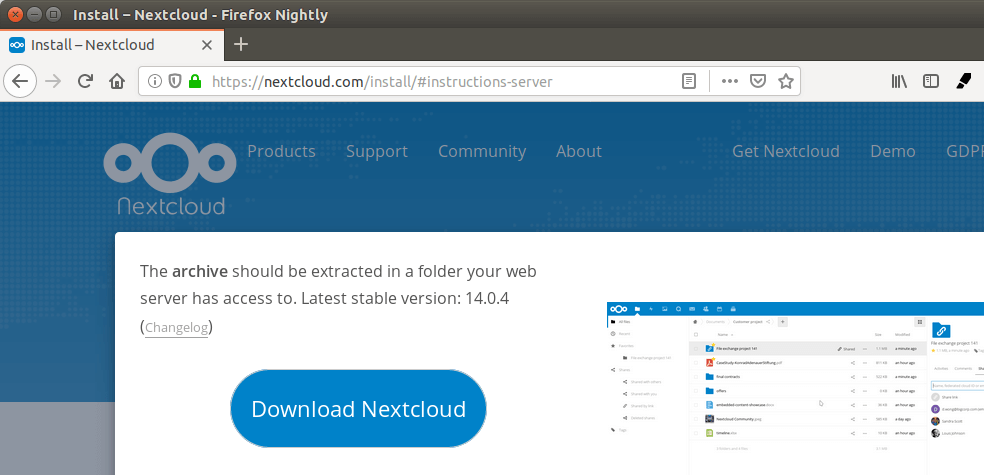
You can use the wget tool to download it from command line. The download link is always available in the format below. If a new version comes out, simply replace 14.0.4 with the new version number.
yum install wget
wget https://download.nextcloud.com/server/releases/nextcloud-14.0.4.zip
Once downloaded, extract the archive with unzip.
yum install unzip
unzip nextcloud-14.0.4.zip -d /usr/share/nginx/
The -d option specifies the target directory. NextCloud web files will be extracted to /usr/share/nginx/nextcloud/. Then we need to change the owner of this directory to nginx so that Nginx web server can write to this directory.
chown nginx:nginx /usr/share/nginx/nextcloud/ -R
Step 2: Create a Database and User in MariaDB
Log into MariaDB database server with the following command. You will need to enter the MariaDB root password to login.
mysql -u root -p
Then create a database for Nextcloud. This tutorial name the database nextcloud. You can use whatever name you like.
CREATE DATABASE nextcloud DEFAULT CHARACTER SET utf8mb4 COLLATE utf8mb4_general_ci;
Create the database user. Again, you can use your preferred name for this user. Replace your-password with your preferred password.
CREATE USER nextclouduser@localhost IDENTIFIED BY 'your-password';
Grant this user all privileges on the nextcloud database.
GRANT ALL PRIVILEGES ON nextcloud.* TO nextclouduser@localhost;
Flush privileges and exit.
flush privileges; exit;
Step 3: Create a Nginx Config File for Nextcloud
Create a nextcloud.conf file in /etc/nginx/conf.d/ directory. I use the Nano command line text editor in this article.
nano /etc/nginx/conf.d/nextcloud.conf
Put the following text into the file. Replace the red-colored text with your actual data. In your DNS manager, create a sub-domain for your NextCloud server like nextcloud.your-domain.com and don’t forget to set A record for the sub-domain.
server {
listen 80;
listen [::]:80;
server_name nextcloud.your-domain.com;
# Add headers to serve security related headers
add_header X-Content-Type-Options nosniff;
add_header X-XSS-Protection "1; mode=block";
add_header X-Robots-Tag none;
add_header X-Download-Options noopen;
add_header X-Permitted-Cross-Domain-Policies none;
add_header Referrer-Policy no-referrer;
#I found this header is needed on Debian/Ubuntu/CentOS/RHEL, but not on Arch Linux.
add_header X-Frame-Options "SAMEORIGIN";
# Path to the root of your installation
root /usr/share/nginx/nextcloud/;
access_log /var/log/nginx/nextcloud.access;
error_log /var/log/nginx/nextcloud.error;
location = /robots.txt {
allow all;
log_not_found off;
access_log off;
}
# The following 2 rules are only needed for the user_webfinger app.
# Uncomment it if you're planning to use this app.
#rewrite ^/.well-known/host-meta /public.php?service=host-meta last;
#rewrite ^/.well-known/host-meta.json /public.php?service=host-meta-json
# last;
location = /.well-known/carddav {
return 301 $scheme://$host/remote.php/dav;
}
location = /.well-known/caldav {
return 301 $scheme://$host/remote.php/dav;
}
location ~ /.well-known/acme-challenge {
allow all;
}
# set max upload size
client_max_body_size 512M;
fastcgi_buffers 64 4K;
# Disable gzip to avoid the removal of the ETag header
gzip off;
# Uncomment if your server is build with the ngx_pagespeed module
# This module is currently not supported.
#pagespeed off;
error_page 403 /core/templates/403.php;
error_page 404 /core/templates/404.php;
location / {
rewrite ^ /index.php;
}
location ~ ^/(?:build|tests|config|lib|3rdparty|templates|data)/ {
deny all;
}
location ~ ^/(?:\.|autotest|occ|issue|indie|db_|console) {
deny all;
}
location ~ ^/(?:index|remote|public|cron|core/ajax/update|status|ocs/v[12]|updater/.+|ocs-provider/.+|core/templates/40[34])\.php(?:$|/) {
include fastcgi_params;
fastcgi_split_path_info ^(.+\.php)(/.*)$;
try_files $fastcgi_script_name =404;
fastcgi_param SCRIPT_FILENAME $document_root$fastcgi_script_name;
fastcgi_param PATH_INFO $fastcgi_path_info;
#Avoid sending the security headers twice
fastcgi_param modHeadersAvailable true;
fastcgi_param front_controller_active true;
fastcgi_pass unix:/run/php-fpm/www.sock;
fastcgi_intercept_errors on;
fastcgi_request_buffering off;
}
location ~ ^/(?:updater|ocs-provider)(?:$|/) {
try_files $uri/ =404;
index index.php;
}
# Adding the cache control header for js and css files
# Make sure it is BELOW the PHP block
location ~* \.(?:css|js)$ {
try_files $uri /index.php$uri$is_args$args;
add_header Cache-Control "public, max-age=7200";
# Add headers to serve security related headers (It is intended to
# have those duplicated to the ones above)
add_header X-Content-Type-Options nosniff;
add_header X-XSS-Protection "1; mode=block";
add_header X-Robots-Tag none;
add_header X-Download-Options noopen;
add_header X-Permitted-Cross-Domain-Policies none;
# Optional: Don't log access to assets
access_log off;
}
location ~* \.(?:svg|gif|png|html|ttf|woff|ico|jpg|jpeg)$ {
try_files $uri /index.php$uri$is_args$args;
# Optional: Don't log access to other assets
access_log off;
}
}
In nano text editor, press Ctrl+O to save the file. Then press Enter to confirm. Press Ctrl+X to exit. Then test Nginx configuration.
nginx -t
If the test is successful, reload Nginx for the changes to take effect.
systemctl reload nginx
Step 4: Install and Enable PHP Modules
Run the following commands to install PHP modules required or recommended by NextCloud.
yum install php-common php-gd php-json php-curl php-zip php-xml php-mbstring php-bz2 php-intl
We also need to tell SELinux (Security Enhenced Linux) to allow PHP-FPM to use execmem.
setsebool -P httpd_execmem 1
Then reload PHP-FPM
systemctl reload php-fpm
Step 5: Setting up Permissions
First, tell SELinux to allow Nginx and PHP-FPM to read and write to the /usr/share/nginx/nextcloud/ directory.
chcon -t httpd_sys_rw_content_t /usr/share/nginx/nextcloud/ -R
By default, SELinux forbids Nginx to make network requests to other servers, but later Nginx needs to request TLS certificate status from Let’s Encrypt CA server, so we need to tell SELinux to allow Nginx with the following command.
setsebool -P httpd_can_network_connect 1
By default, there are 3 files in /var/lib/php/ directory whose group owner are set to apache, but we are using Nginx. So we need to give the nginx user permissions to read and write to the 3 directories with setfacl.
setfacl -R -m u:nginx:rwx /var/lib/php/opcache/ setfacl -R -m u:nginx:rwx /var/lib/php/session/ setfacl -R -m u:nginx:rwx /var/lib/php/wsdlcache/
Step 6: Enable HTTPS
Now you can access the Nextcloud web install wizard in your browser by entering the domain name for your Nextcloud installation.
nextcloud.your-domain.com
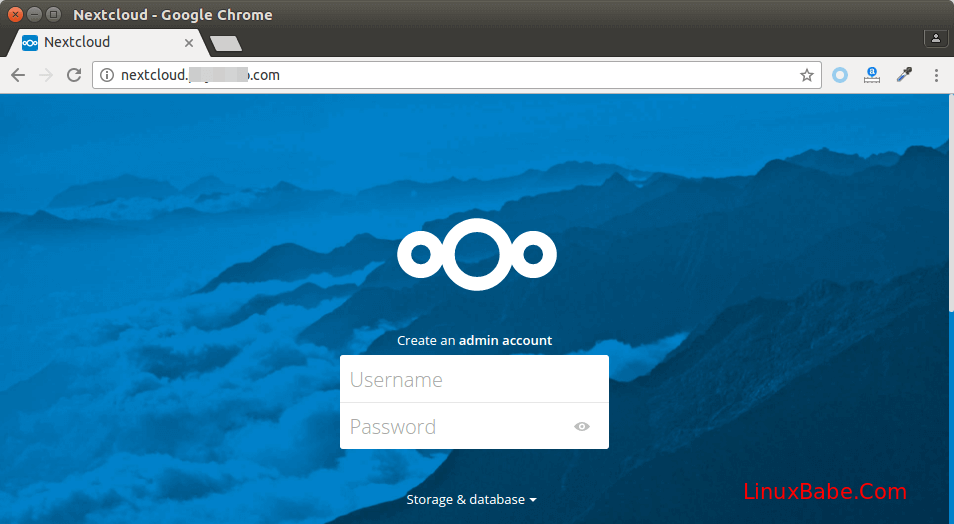
If the web page can’t load, you probably need to open port 80 in firewall.
firewall-cmd --permanent --zone=public --add-service=http
And port 443 as well.
firewall-cmd --permanent --zone=public --add-service=https
The --permanent option will make this firewall rule persistent across system reboots. Next, reload the firewall daemon for the change to take effect.
systemctl reload firewalld
Now the NextCloud install wizard should be loaded successfully. Before entering any sensitive information, we should enable secure HTTPS connection on Nextcloud. We can obtain a free TLS certificate from Let’s Encrypt.
Download Let’s Encrypt client certbot-auto from EFF website.
wget https://dl.eff.org/certbot-auto
Give execute permission.
chmod a+x certbot-auto
Move it to user’s PATH, like /usr/local/bin/ and rename it to certbot.
sudo mv certbot-auto /usr/local/bin/certbot
Set root as the owner and change the permission to 0755.
sudo chown root /usr/local/bin/certbot sudo chmod 0755 /usr/local/bin/certbot
Now we can use certbot command to obtain a free TLS certificate using the Nginx plugin.
sudo /usr/local/bin/certbot --nginx --agree-tos --redirect --hsts --staple-ocsp --email your-email-address -d nextcloud.your-domain.com
Where:
- –nginx: Use the Nginx authenticator and installer
- –agree-tos: Agree to Let’s Encrypt terms of service
- –redirect: Add 301 redirect so that HTTP requests will be redirected to HTTPS.
- –hsts: Add the Strict-Transport-Security header to every HTTP response.
- –staple-ocsp: Enables OCSP Stapling to improve performance and user privacy.
- -d flag is followed by a list of domain names, separated by comma. You can add up to 100 domain names.
- –email: Email used for registration and recovery contact.
If this is a first run on RHEL 8/CentOS 8 system, you may be asked to install some dependency packages. Press y to continue.
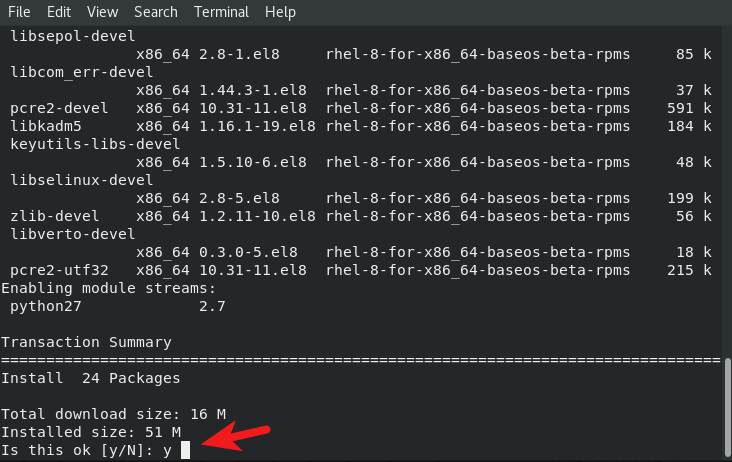
You will be asked if you want to receive emails from EFF(Electronic Frontier Foundation). After choosing Y or N, your TLS certificate will be automatically obtained and configured for you, which is indicated by the message below.
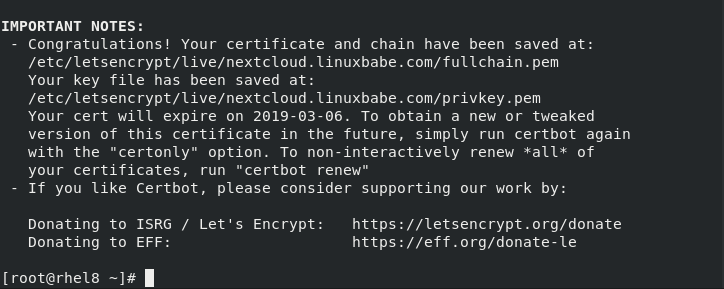
Finish the Installation in your Web Browser
Now you can access the Nextcloud web install wizard using HTTPS connection. To complete the installation, you need to create an admin account, enter the path of Nextcloud data folder, enter database details created earlier. You can use the default localhost as host address, or you can enter localhost:3306, as MariaDB listens on port 3306.
The data folder is where users’ files are stored. For security, it’s best to place the data directory outside of Nextcloud web root. So instead of storing users’ files under /usr/share/nginx/nextcloud/data/, we can change it to /usr/share/nginx/nextcloud-data. which can be created with the following command:
mkdir /usr/share/nginx/nextcloud-data
Then make sure Nginx user has write permission to the data directory.
chown nginx:nginx /usr/share/nginx/nextcloud-data -R chcon -t httpd_sys_rw_content_t /usr/share/nginx/nextcloud-data/ -R
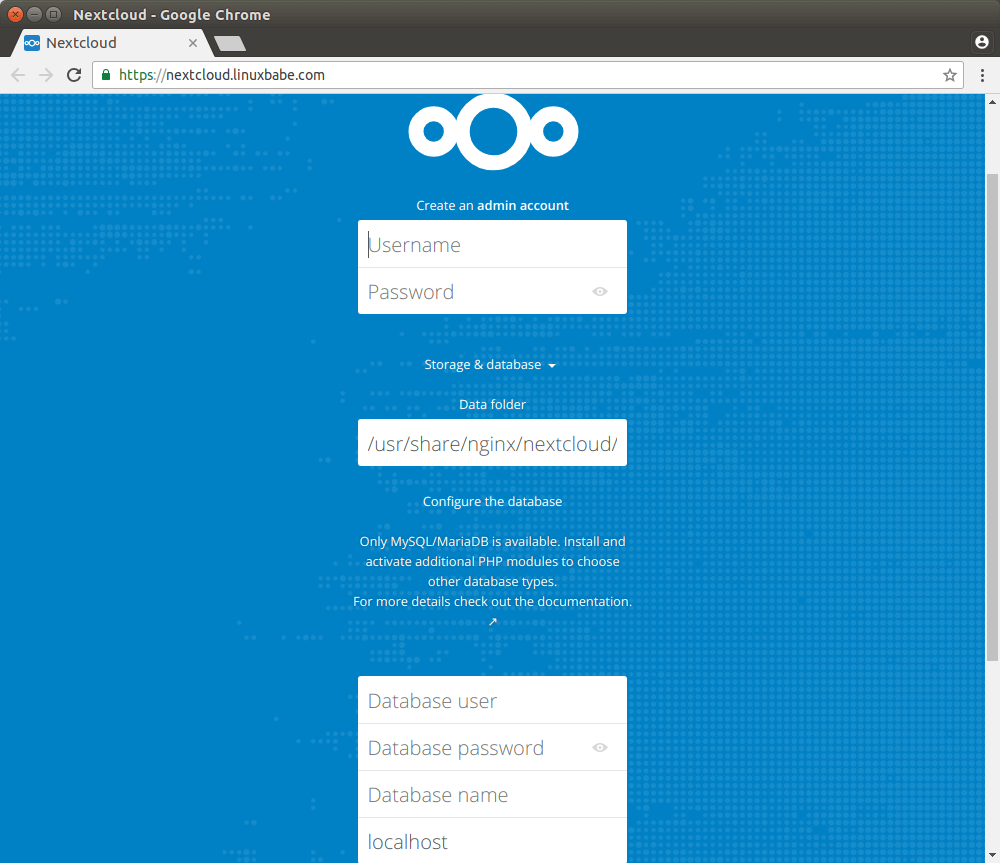
Once it’s done, you will see the Web interface of Nextcloud. Congrats! You can start using it as your private cloud storage.
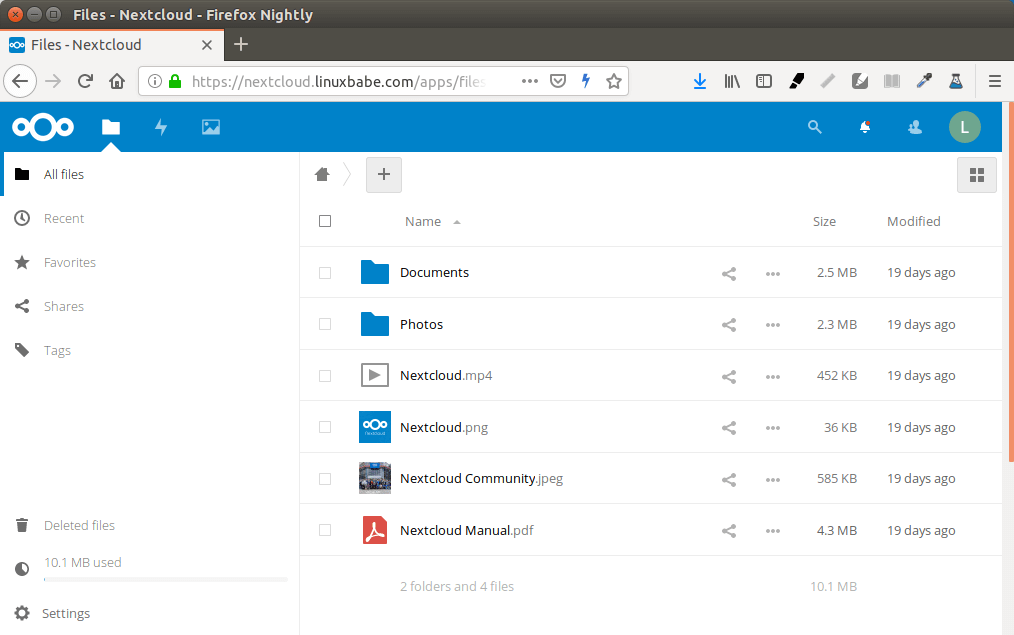
How to Set up NextCloud Email Notification
If your NextCloud instance will be used by more than one person, it’s important that your NextCloud server can send transactional emails, such as password-resetting email. To configure email settings, go to Settings -> Basic settings. You will find the email server settings.
There are two send modes: sendmail and smtp. The sendmail mode is available if your NextCloud host has a SMTP server running.
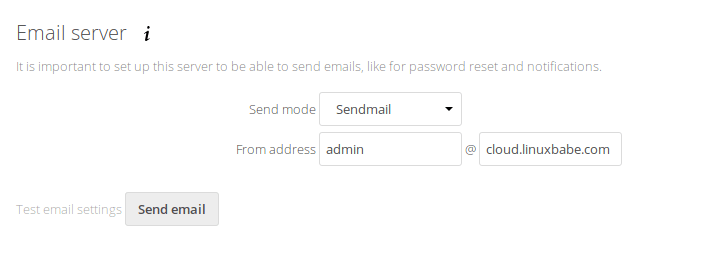
If you would like to use a SMTP server running on another host, then choose smtp mode and enter the login credentials like below.
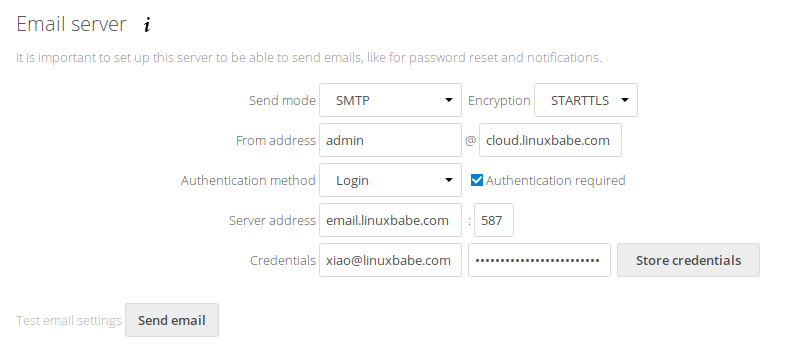
You also need to tell SELinux to allow Nginx to send mail with the following command.
setsebool -P httpd_can_sendmail on
For how to set up your own email server, read the following tutorial:
Increase Upload File Size Limit
The default maximum upload file size limit set by Nginx is 1MB. To allow uploading large files to your NextCloud server, edit the Nginx configuration file for NextCloud.
nano /etc/nginx/conf.d/nextcloud.conf
We have already set the maximum file size in this file, as indicated by
client_max_body_size 512M;
You can change it if you prefer, like 1G.
client_max_body_size 1024M;
Save and close the file. Then reload Nginx for the changes to take effect.
systemctl reload nginx
PHP also sets a limit of upload file size. The default maximum file size for uploading is 2MB. To increase the upload size limit, edit the PHP configuration file.
nano /etc/php.ini
Find the following line (line 827).
upload_max_filesize = 2M
Change the value like below:
upload_max_filesize = 1024M
Save and close the file. Alternatively, you can run the following command to change the value without manually opening the file.
sed -i 's/upload_max_filesize = 2M/upload_max_filesize = 1024M/g' /etc/php.ini
Then restart PHP-FPM.
systemctl restart php-fpm
Install Nextcloud Desktop Client
CentOS Stream/Rocky Linux/Alma Linux/Fedora:
sudo dnf install nextcloud-client
Auto-Renew Let’s Encrypt Certificate
Edit root user’s crontab file.
sudo crontab -e
Add the following line at the end of the file to run the Cron job daily. If the certificate is going to expire in 30 days, certbot will try to renew the certificate. It’s necessary to reload the Nginx service to pick up new certificate and key file.
@daily certbot renew --quiet && systemctl reload nginx
Wrapping Up
I hope this tutorial helped you install NextCloud on RHEL 8/CentOS 8 server. You might also want to use Nginx Amplify to monitor Nextcloud back end performance.
As always, if you found this post useful, then subscribe to our free newsletter to get more tips and tricks. Take care 🙂



chown: invalid user: ‘nginx:nginx’
Looks like your Nginx is not installed from the default repository. Check what user your Nginx run as:
Hi admin
How to renew Lets Encrypt TLS Certificate in this post ?
Just rerun command:
“certbot –nginx –agree-tos –redirect –hsts –staple-ocsp –email your-email-address -d nextcloud.your-domain.com”
or other way ?
Thanks so much
You can simply run the following command to renew certificate.
To automatically renew Let’s Encrypt Certificate, edit root user’s crontab file.
Add the following line at the end of the file to run the Cron job daily. If the certificate is going to expire in 30 days, certbot will try to renew the certificate. It’s necessary to load Nginx service to pick up new certificate and key file.
I got to the point where I could access the create an admin account page through my subdomain (nextcloud.exampledomain.com), but after I used certbot as the instructions said, the page no longer loads and says it’s timed out. I can still access the default nginx test page (www.exampledomain.com) which I left unencrypted. I’m kinda stuck here.
Any help would be appreciated.
Is it something to do with my port forwarding/dns setup for my domain? Or is it something else?
hi – can you please update this (or add instructions?) so I can also install Nextcloud on my local network? was able to follow guide on adding and testing LEMP – but on locally running it i got lost 🙁
thanks for the guide!
Great write up!!
Unfortunately I have hit a snag, and I’m sure its something I’ve missed.
All good up till I trying and create the ssl cert. I get a “Challenge failed for domain”.
I have validated my firewall port forward (and dns entry) by redirecting to port 80 as a test, nextcloud loads successfully from public side using 443.
When I look in my nextcloud install folder I do not see “.well-know” folder. Should I be running certbot from a partiular locaton? (ex /usr/share/nginx/nextcloud/)
Do I need to tell nginx to listen on 443?
Any ideas? TKS
…and reading my own post I figured out my problem… cerbot is validating via port 80 which I did NOT have accessible from public.
Certbot is included in Epel repo, which is preferred to manual installs, so you get updates.
Hi,
Am i the only one that noticed that the initially created nginx config file is superseeded by another one altered by certbot, making Nextcloud not working.
The initial file was created for port 80 (without SSL) and Certbot adds many SSL lines.
I’d say both need to be merged and nginx restarted.
Certbot would add 301 redirect and Nextcloud would be working on port 443. No need to merge the two files.
It looks like nginx reads config files from cinf.d directory first and then carries on with reading stuff from nginx.conf and since nginx.conf is modified by certbot the server is looking for its html/php files in /usr/share/nginx/html whileit should be /usr/share/nginx/nextcloud.
Since nextcloud.conf is prepared for serving web pages without ssl it might be better to modify it for ssl at the end and read it after nginx.conf.
I’ll test it in free time.
Hi there,
It is a fantastic article and working fine with http. However, I am also facing the similar problem with HTTPS.
How to fix this problem?
Thank you for this article.
Now i have a working subdomain nextcloud.domain.com
How can i set the Main domain to use ssl and show any conten.
And how can i set in ngings any other subdomain?
When i open the domain.com it gives me a ssl error.
Followed it to the “T”
OUTSTANDING!!!!
Made a new install of CentOS8, then install LEMP as linked in this article… now i get an internal server error in nextcloud-design.
The nextcloud.error log reads as follows (changed IP and hostname, for obvious reasons):
[error] 5402#0: *1 FastCGI sent in stderr: "PHP message: PHP Warning: fileperms(): stat failed for /usr/share/nginx/nextcloud/data/nextcloud.log in /usr/share/nginx/nextcloud/lib/private/Log/File.php on line 137 PHP message: {"reqId":"c8s6mpr0tXjFyMDPMCw6","level":3,"time":"2020-12-27T13:51:16+00:00","remoteAddr":"192.168.x.x","user":"--","app":"PHP","method":"GET","url":"\/","message":"fileperms(): stat failed for \/usr\/share\/nginx\/nextcloud\/data\/nextcloud.log at \/usr\/share\/nginx\/nextcloud\/lib\/private\/Log\/File.php#137","userAgent":"Mozilla\/5.0 (Windows NT 10.0; Win64; x64) AppleWebKit\/537.36 (KHTML, like Gecko) Chrome\/87.0.4280.88 Safari\/537.36","version":""} PHP message: {"reqId":"c8s6mpr0tXjFyMDPMCw6","level":3,"time":"2020-12-27T13:51:16+00:00","remoteAddr":"192.168.x.x","user":"--","app":"PHP","method":"GET","url":"\/","message":"chmod(): No such file or directory at \/usr\/share\/nginx\/nextcloud\/lib\/private\/Log\/File.php#138","userAgent":"Mozilla\/5.0 (Windows NT 10.0; Win64; x64) AppleWebKit\/537.36 (KHTML, like Gecko) Chrome\/87.0.4280.88 Safari\/537.36","version":""}" while reading upstream, client: 192.168.x.x, server: my.server.changed, request: "GET / HTTP/1.1", upstream: "fastcgi://unix:/run/php-fpm/www.sock:", host: "my.server.changed"Checked the location /usr/share/nginx/nextcloud/ – there is no data folder and no nextcloud.log of course. Created both, set them to the nextcloud user, nothing changed.
Any Ideas what am I missing?
Can’t believe I found this site This looks like a great spot for reading over expert ideas. This forum is completely rare and will help me with my ideas. I bookmarked this web page and will be comming back for more information. I stumbled across the expert knowledge that I had previously hunted all over the place and just couldn’t locate. What a perfect website. On my spare time I am forever fascinated Expert roofing.